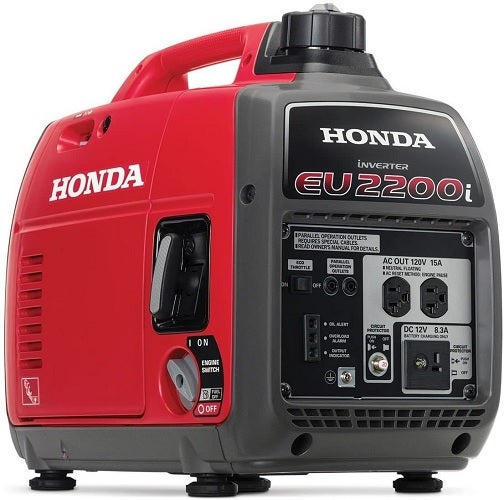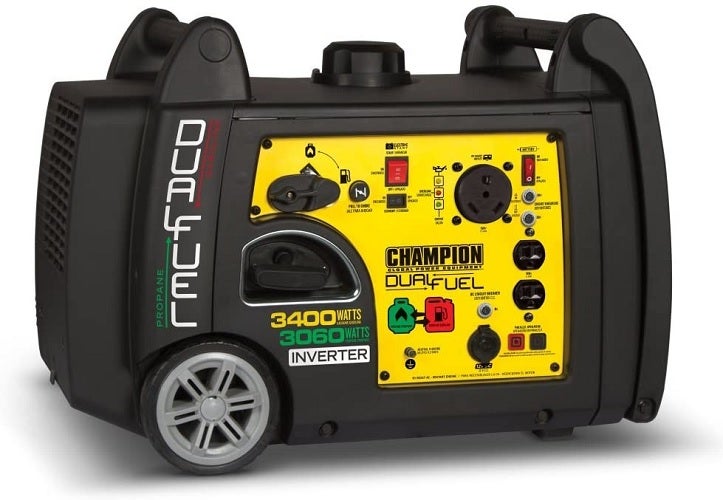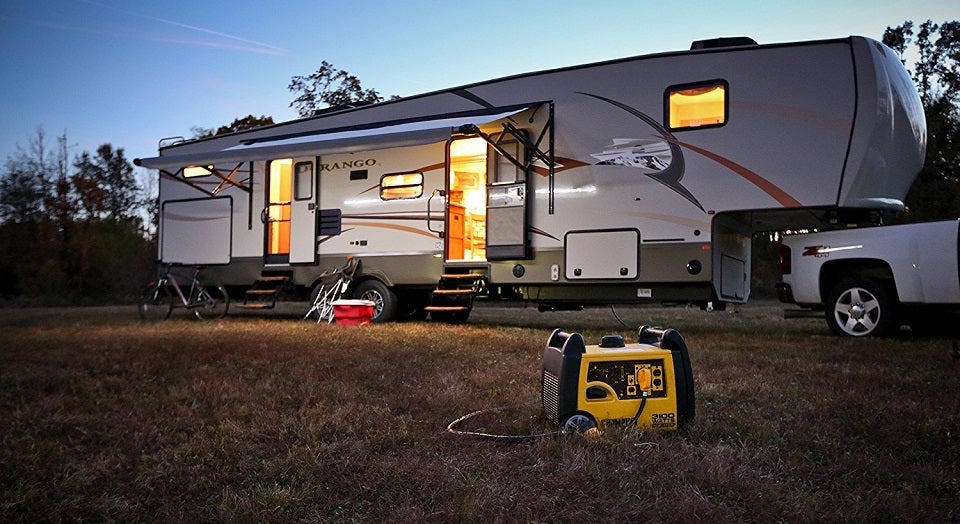
Our Editors independently research, test, and rate what we feel are the best products. We use affiliate links and may receive a small commission on purchases.
Today you can buy portable generators with built in inverters and plugs with American outlets, European outlets even generic USB charging docks.
It’s never been easier to get outside and have reliable power for just about any accessory or appliance you can think of.
We’re going to talk about the differences between some of these common electronic power banks and power inverters so you know what you’re buying. I’m also going to help you navigate a few top rated inverter generators.
Best Inverter Generators
For more of my camping recommendations, have a look through these popular Outside Pursuits guide links: Family Camping Tents, Truck Bed Tents, Pop Up Canopies.
Quick Answer: The 5 Best Rated Inverter Generators For 2021
- Honda EU2200i Portable Inverter Generator
- Champion RV Ready Portable Inverter Generator
- Yamaha EF2000iSv2 Gas Powered Portable Inverter
- Westinghouse iGen2200 Portable Inverter Generator
- WEN CARB Compliant Inverter Generator
Our reviews of the top inverter generators along with our comparison table and buyers guide will help you choose the right one for you.
Inverter Generator Reviews
#1 Honda EU2200i Portable Inverter Generator
- Run Time: 4.0 to 9.6 Hours
- Power: 2200 Watts
- Noise Level: 48-57 dB
- Other: Can be run in parallel
Honda is a name in engines that has been around for ages and is our Editors Choice for the best inverter generator.
Honda knows how to make a quality gas engine and that’s a good thing when the engine is the main component of an inverter generator.
If you know anything about gas engines, especially small gas engines that don’t get used often, you know it’s hard to keep them running well.
One way to help this out is to run the generator motor dry at the end of a trip. To do this you need a fuel shutoff valve (or just run the tank dry) which is why I love that feature on this inverter.
Depending on the load on this inverter it will run from 48-57 dB which is mildly annoying to quite loud. You can solve that, however, by hiding it behind the RV or something.
I do like the overall compact size, number of power outlets, and clean styling for this Honda generator.
It won’t be getting your car or truck dirty when you pack it up and the easy to carry handle makes the whole thing easy to transport.
Best For: Light camping and keeping on hand when the need arises for small power.
#2 Champion RV Ready Dual Fuel Inverter Generator
- Run Time: 7.5 Hours
- Power: 3,400 Watts
- Noise Level: 59 dB
- Other: Low oil shutoff sensor
This RV ready generator inverter has enough outlets to take care of anything you can throw at it. Plus, at 3,100 running watts it should be able to handle just about anything.
While I don’t love the styling of this generator as much as the Honda, I do like some of the little details. One such detail that really matters is the low oil sensor.
Because many of us aren’t engine mechanics, a little backup like this is handy so we don’t blow up an engine.
On top of that this Champion generator is capable of cranking out a peak 3,400 Watts of power. You’ll need all of that if you want to run an entire RV off one generator.
At a moderate load you’ll be lucky to get about 8 hours of use out of a tank of gas and 14.5 hours with a tank of propane.
One thing that I can’t say enough about is the 3-year limited warranty. If something goes wrong it’s nice to have a manufacturer that will stand behind their products.
Best For: RV campers looking for the best portable generator that will provide enough power for almost all of thier needs.
#3 Yamaha EF2400iSHC Gas Powered Portable Inverter
- Run Time: 8.6 Hours @ quarter load
- Power: 2,000 Watts
- Noise Level: 51.5 dB @ quarter load
- Other: Low oil light
Yamaha, like Honda has had a long history of making engines and engine components. They also happen to have a great product design team that really just knocked the aesthetics out of the park on this one.
Let’s start by addressing the tiny size of this gas powered generator inverter. It’s SO SMALL! I really love how tiny thing thing is because it’s perfect for compact needs.
Maybe you’re going camping but you’re taking the car and don’t have much room. This is the one for you!
Because of the compact size and low overall output, you’ll not find an RV plug here. This is more for those occasional use times when you need to hook up a battery charger, electric cooking utensils, or other short use needs.
Since it’s so small in output capacity, you’ll be happy to know that it can be run parallel with another unit for more juice!
Best For: Car camping, emergencies and anyone looking for the best tailgating generator!
#4 Westinghouse iGen2200 Portable Inverter Generator
- Run Time: 12 Hours @ quarter load
- Power: 1,800 Watts (other sizes up to 4,500 Watts)
- Noise Level: 52 dB
- Other: CARB Compliant
This little dude isn’t as compact as the Yamaha but it’s not as big as the Champion either. This is the middle ground between the two with some compact size and a bit of power output.
I know we haven’t talked about it on all the inverters but runtime is important. This one has one of the better run times of 12 hours at 25% load.
The reason it’s hard to compare, however, is that many manufacturers will list run times at various (or undisclosed) loads. That makes it almost impossible to get an apples to apples scenario.
That said this is hands down the most versatile generator lineup on our list. It’s not the generator itself, but rather the fact that you can get it in 1,200 Watt to 4,5000 Watt models.
There’s a model that’s the right size for everyone in here so take a look.
Did I mention that you can piggyback these small portable generators? Two 4,500 Watts running in parallel means you can get enough juice to run several military grade spotlights and the A/C unit if you want to.
Disclaimer: I don’t actually know if you can run a spotlight off this inverter – it was an exaggeration.
I also love that this inverter has USB plugs directly on it. With the proliferation of USB powered devices this seems like a necessity today.
Best For: Campers/hunters/fishermen who need a portable power inverter of just the right size.
#5 WEN CARB Compliant Inverter Generator
- Run Time: 8.5 Hours @ Half load
- Power: 8,800 Watts
- Noise Level: 57 dB @ Half load
- Other: EPA III and CARB Compliant
A couple of our larger inverters are so big they actually are easier to roll than carry. This is one of them and it’s a beast ready to light up your RV, house, or camping trip.
I was going to give this inverter the top pick for RV use but I love the dual fuel capability of the Champion.
I will say, however, that the WEN gives it a run for the money. The WEN pulls slightly ahead in some aspects however, because the slightly higher output and the inclusion of little details like 2 USB ports right on the unit make a difference.
If you don’t think you care about USB plugs on the inverter (after all you can just plug them in inside the RV, right?) then go with the Champion model for ease of use.
Best For: Those who want to piggyback two units for max power in a camping setting.
Portable Power Inverter Comparison Table
| Portable Generator | Power | Run Time | Noise Level | Current | Rating | |
|---|---|---|---|---|---|---|
| Honda EU2200i Portable Generator | 2200 Watts | 4.0 - 9.6 Hrs | 48-57 dB | 18A | 4.9 / 5.0 | |
| Champion Dual Fuel Inverter Generator | 3,400 Watts | 7.5 Hrs | 59 dB | 25.8A | 4.7 / 5.0 | |
| Yamaha EF2400iSHC Gas Powered Portable Inverter | 2,000 Watts | 10.5 Hrs | 51.5 dB | 16.7A | 4.3 / 5.0 | |
| Westinghouse iGen2200 Generator | 1,800 Watts | 12 Hrs | 52 dB | 20A | 4.3 / 5.0 | |
| WEN CARB Compliant Inverter Generator | 3,800 Watts | 8.5 Hrs | 57 dB | 30A | 3.9 / 5.0 |
How to Choose the Best Inverter Generator for You
- How Big of a Inverter Generator Do I Need?
- Noise Levels
- Number of Outlets on the Inverter Generator
- Peak Watts vs Running Watts
- Running Inverter Generators in Parallel
- RV Plugs
- FAQs For Inverter Generators
Now let’s go over what you need to know about portable inverter generators, that way you’ll be able to spend more time camping and RVing and less time searching around the internet for the info you need.
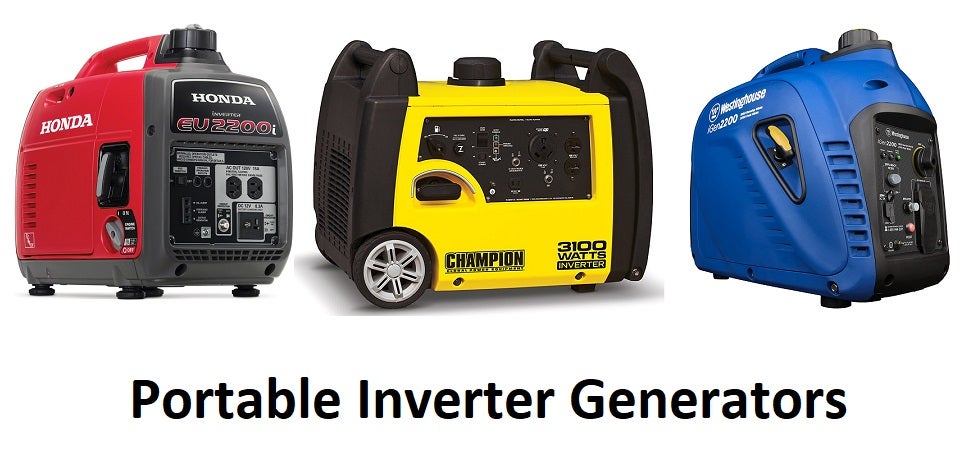
How Big of a Inverter Generator Do I Need?
“Big” in terms of inverters and generators really refers to power output measured in watts. In confusing physics terms, (W = AV) or watts equals amps times volts.
Therefore, to truly understand how big of a generator you need all you need to know is the draw and voltage of every device that will be feeding off the inverter.
So, let’s say you have a device that pulls 1.2 amps at 5 volts (common for USB chargers). That device will consume 6 amps of power from your generator. If you wanted to run 100 of those at the same time you’d need at least a 600W inverter.
This number begins to skyrocket as soon as you use larger items. For instance:
- Charcoal starter – 600W
- Single Burner Electric Range – 800W
- String of Lights (Edison Style LED) – 30W
Those are just a few small examples of power draw from some common camping items you might hook up to a generator inverter. Running those at the same time will take 1430W of power output from your inverter.
Fortunately, most modern inverter generators range from about 1,400W to 4,000W of output.
If you go through the process of adding up the devices power consumption that you want to use be sure to add about an extra 25% to the final number. This will account for additional items and parasitic consumption caused by extension cords, etc.
If you’re running your RV off the inverter generator then make sure it has enough juice to power hungry items like the air conditioner. These devices are super power hungry so you may have to only run them occasionally.
Noise Levels
Generator inverters get their power from spinning magnets inside of copper wire coils. It’s basically magic, but it works. At the end of the day what this means to you is that the gas engine being used to power most generators is always noisy to some degree.
The last thing we want (and the people around you want) on a nice quiet camping evening is a loud generator buzzing away. Yuck!
Noise level is measured in dB or decibels. Decibel levels under 75 dB are usually safe for long exposures and, while annoying, won’t hurt anyone. Noise levels above 85 dB are unsafe and can cause long term hearing damage (source).
Most quiet portable generators will run from about 45 (very quiet) to 65 (quite loud). Anything at or under 50 is pretty darn quiet for a gas motor. Anything at or above 60 will probably start to earn you enemies among nearby campers.
Many inverter generators use adaptive output which means the engine runs harder when you’re drawing more power and it quiets down when less power is being used. An inverter with this feature will help appease the neighbors and prevent their dogs from barking at your inverter constantly.
Tip: Hide your inverter on the side of your tent/RV/car that is facing away from your campsite and other people. This will help deflect direct noise from the inverter and lower the overall sound signature.
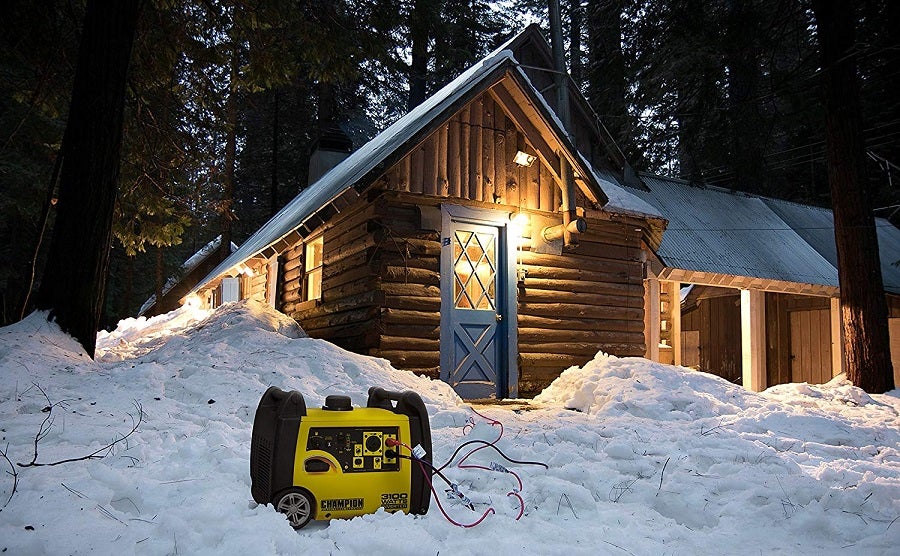
Number of Outlets on the Inverter Generator
I have no idea what you’ll be using that inverter for when you go out with it. I’m assuming you may want to use it for outdoor living or camping, right?
Well, you’ll have to do a little thought experiment with me. Go back to the last time you went out on a similar camping trip.
- How many electronics do you use?
- How often were you using them?
- How many did you use at the same time?
Most inverters will have a couple of outlets of various types. If you’re only using one or two types of plugs, there’s no sense in going for an inverter with a huge smorgasboard of outlet types. Keep it simple.
Plugging devices right into the inverter is by far the most effective way to do it. Using a power strip or extension cord can be done, but every time you piggyback something off electronic devices they lose power.
Each additional length of cord or outlet plug adds resistance to the circuit which will draw power off the inverter. When you’ve got a limited amount of power output, like an inverter, you want to be as efficient as possible so always try to plug devices directly into the inverter.
Peak Watts vs Running Watts
Be careful with some of this language when shopping. Manufacturers will try to fool you by playing with words when they label these devices.
So, how do you navigate around these tricky labels?
Peak watts will often be cited as the main “number” when you’re buying. If an inverter generator says 3,000 Watts make sure to find out if that’s peak or running watts. If there’s no clear difference look in the specifications.
Peak watts is a label that refers to the maximum possible output of the generator. Generators cannot put out this amount of power all the time, it’s just the maximum theoretical output if everything goes right all at once.
Running watts is a term for the normal sustained output of a generator inverter. That’s the number you really want to be paying attention to. Make sure you don’t get fooled by looking at peak watts when you think you’re reading running watts.
I promise to make sure that each of the inverter generators on our list has the running watts listed clearly.
Running Inverter Generators in Parallel
Sometimes you can use the magic that is electrical engineering to make cool stuff happen. Let’s say you and a friend are going out with your families. You both have a generator that can run parallel. In that case, you can plug those two together and they will boost each other’s output!
Why is this better than just running them separate? It just depends on where your devices are, how high of a load you have, and what you’re using them for. You can piggyback two of them and then plug the RV right into that for a combined max output.
RV Plugs
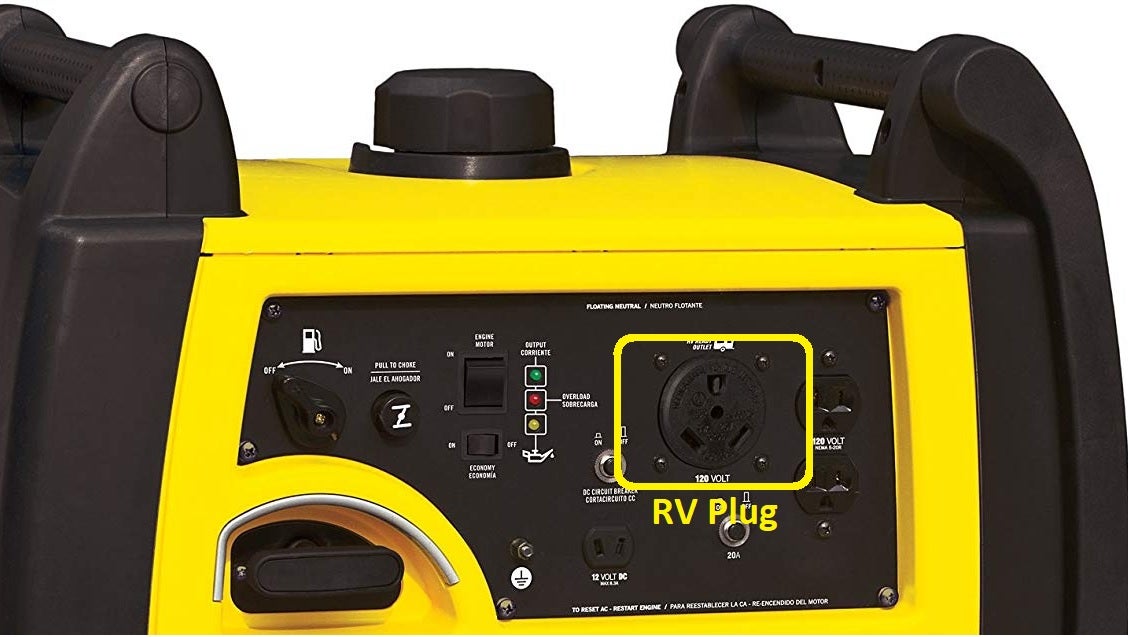
RVs always have those funky plugs that are the size of a small teacup. Fact is, you gotta have an outlet that can accommodate it if you want to power up that RV.
Most inverter generators are made with these outlets, but some are either too small or just don’t have it.
If your generator doesn’t have an RV plug, do not use an adapter unless recommended by the manufacturer. RV plugs should only be plugged into appropriate outlets with safe fuses and circuit or you can damage the inverter, cable, or the RV itself.
That’s an expensive problem!
FAQs For Inverter Generators
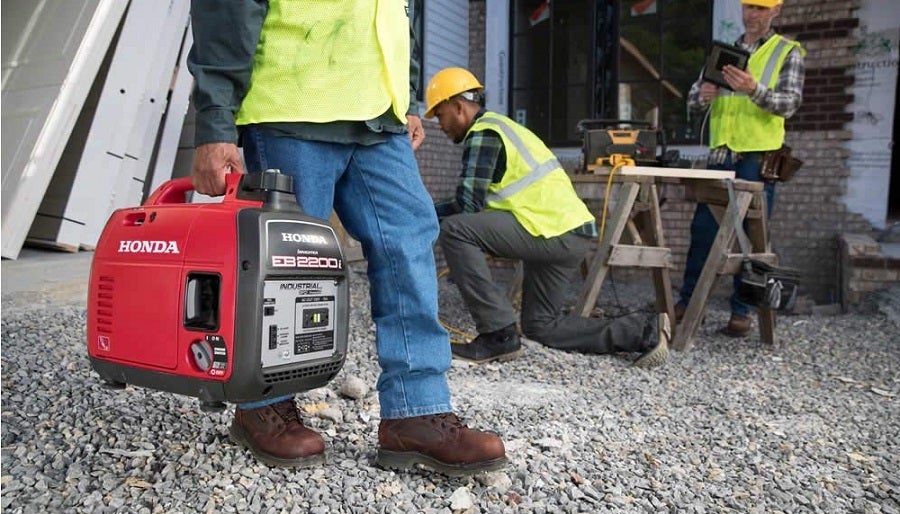
Q: What’s an ECO mode on an inverter?
A: Inverter generators often have some kind of efficiency mode. Usually this is a simple switch that you can turn on to increase efficiency and decrease noise.
Essentially most of these are just bottle necking the output of the generator to reduce fuel consumption and force it to run lower. Sometimes, however, there is much more sophisticated tech behind them.
No matter how these modes function though, they all serve the same purpose. Their job is to either automatically, or manually, detect when lower power needs are present and slow down the inverter to save gas and extend run time.
Q: What is overload protection?
A: No, not “overlord” protection – that’s a totally different thing.
Overload protection is a smart circuitry feature which knows when the generator is being overdrawn and responds by either shutting things down, blowing a fuse, or otherwise interrupting the circuit from making problems.
This is different from surge protection which essentially works in the reverse direction by protecting things “downstream” from huge jumps in voltage.
Q: What do I do if my fuse blows?
A: If you’ve blown a fuse on the generator that means something went wrong in the circuit. Do not reset the fuse and just turn it back on.
Fuses blow when there’s a problem. Identify the problem, solve it, then turn it back on.
Check for loose connections, frayed wires, or water getting into the cords if it’s outside. These can cause shorts which will blow fuses and if they’re not solved will just blow the fuse again.
Normally this isn’t a problem but you’d be silly to just keep resetting it and hoping something gets fixed. Go solve the issue, you silly billy!
Q: What is the difference between a generator and inverter generator?
A: An inverter generator is designed to provide “cleaner” power ie: less noise, voltage fluctuations by running at a a constant 3600 RPMs at 60Hz this is how it provides cleaner power so your electronics run better while being more efficient, and making your gas last longer..
Outside Pursuits Overview
Power inverter generators are essentially smart circuits built into traditional generators. They’re pretty rad and super helpful!
We’ve talked mostly about gas inverters in this article but other types of inverters include solar inverters, hydro inverters, and other tools to change DC current into controlled AC output. It’s basically magic but not really.
If you’re unsure of your needs, try talking to the local RV or camping dealer. They should be able to help you better determine what you can use with your equipment and what to avoid. Usually campers, pop-ups, 5th wheels, and RVs all are very compatible with inverter generators and you’ll love having portable power around!
How We Researched
To come up with the top inverter generators, we researched a variety of sources for reviews such as Camping World, Lazy Days, Real Truck and Walmart along with our own personal experience.
We also consulted online magazines for product research and reviews to get as much unbiased information as we could. To help weed out fake reviews we used Fakespot.com to make sure we only looked at genuine reviews.
With so much quality gear available, we had to narrow it down based on what we felt were the best options for the price. The staff authors have a wide and varied background in RV camping, automotive repairs and backpacking.
The authors have decades of experience and are eager to share their knowledge with readers.
To help narrow down the selection we used personal experiences along with recommendations from mechanics and retailers.
After extensive research, we came up with our list to help you choose the right one for you.
Sources

